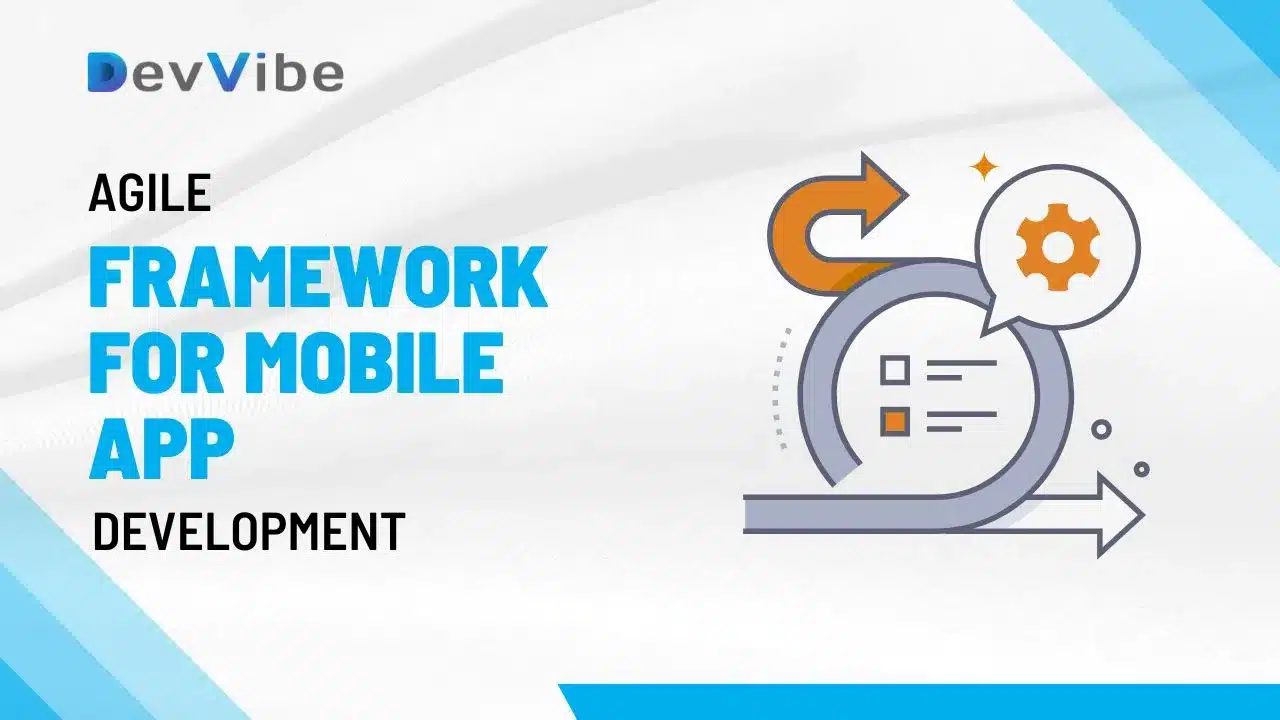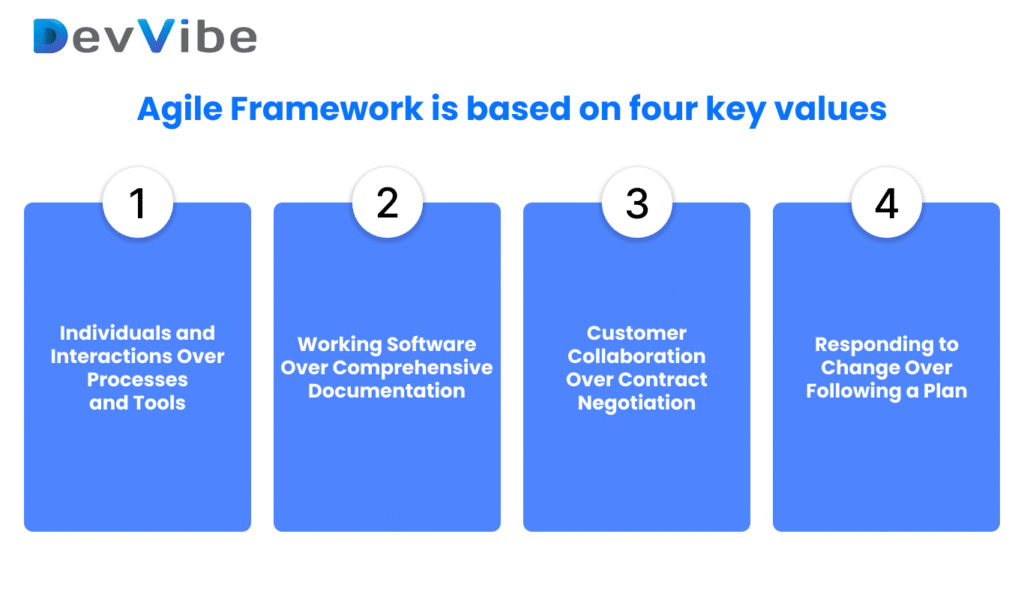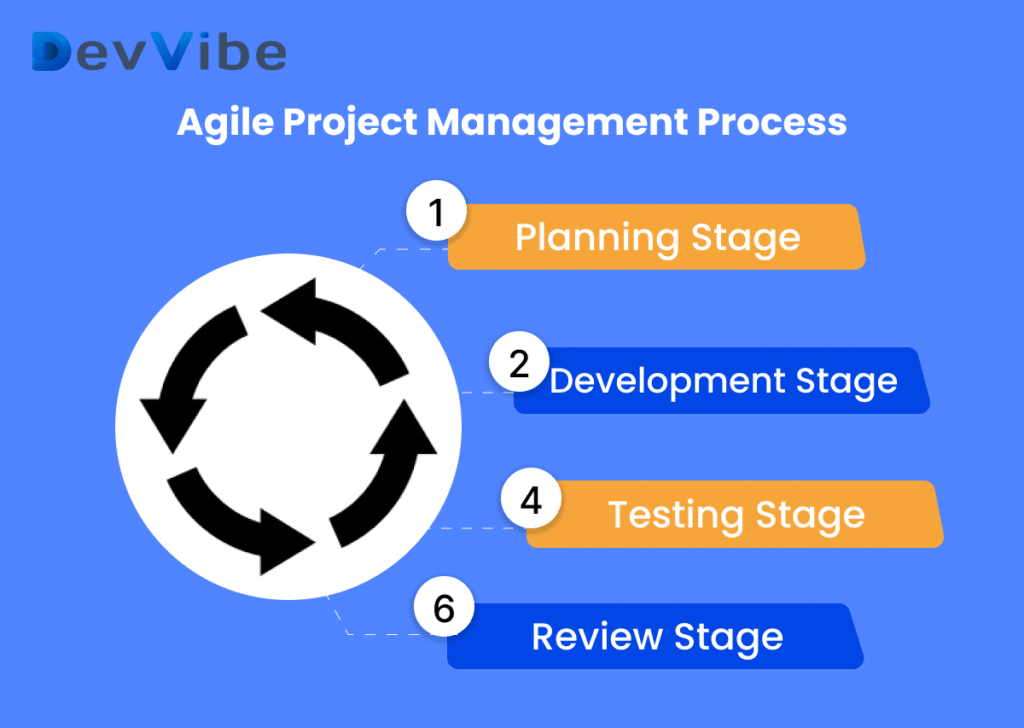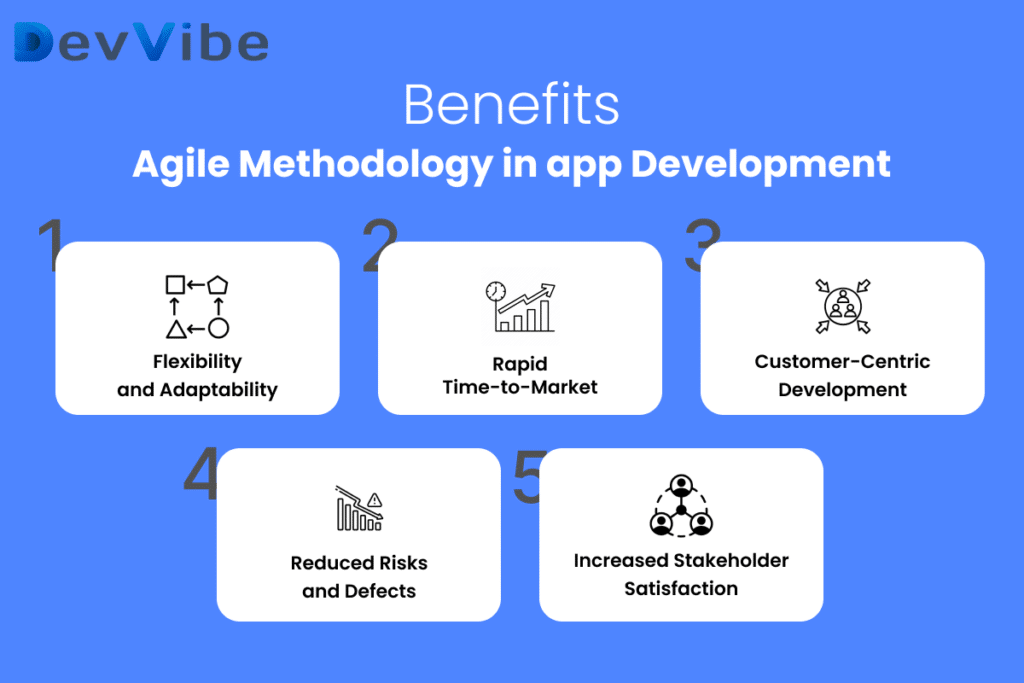
Agile Framework for Mobile App Development | Key Points
In the fast-paced world of mobile app development, the Agile framework has become a key methodology. The Agile Framework is a flexible and repeatable approach to software development that focuses on teamwork, adaptability, and ongoing improvement. It helps development teams deliver high-quality software quickly and efficiently while staying responsive to changing customer needs and market conditions.
In this comprehensive guide, we’ll cover all aspects of the Agile Framework and Agile project management. We’ll discuss into Agile principles and values, the Agile project management process, and popular Agile methodologies. Additionally, we’ll explore the benefits of using Agile framework for mobile app development and share best practices for implementing Agile effectively.
Agile Framework Core Principles
The Agile Framework is based on four key values
Individuals and Interactions Over Processes and Tools
Agile prioritizes the human aspect of software development, focusing on effective communication, collaboration, and teamwork. While tools and processes are important, Agile values direct interactions among team members, recognizing that the best ideas often come from these personal connections.
Working Software Over Comprehensive Documentation
Agile emphasizes delivering a working product rather than spending too much time on documentation. While documentation is still necessary, Agile promotes a balance, ensuring that it supports the development process without slowing it down. The main objective is to have a functional product at the end of each iteration.
Customer Collaboration Over Contract Negotiation
Agile encourages ongoing collaboration with customers and stakeholders throughout the development process. By involving end-users in regular feedback loops, development teams can ensure that the product meets user expectations. This principle fosters flexibility and responsiveness to changing requirements.
Responding to Change Over Following a Plan
Agile embraces change as a natural part of development. Instead of strictly following a predefined plan, Agile teams are encouraged to adapt based on evolving requirements, feedback, and market conditions. This flexibility is vital in the dynamic world of mobile app development, where change is constant.
The Agile Project Management Process
The Agile project management process is an iterative and incremental approach to software development, grounded in the principles of the Agile Framework. It allows development teams to deliver high-quality software more quickly and efficiently, while adapting to changing customer needs and market conditions.
The Agile project management process generally includes the following stages:
Planning Stage
In this stage, the team defines the project’s requirements and goals, and creates a plan to achieve them. This plan is broken down into smaller, more manageable tasks.
Development Stage
The team develops the software according to the plan, working in short cycles called sprints. Each sprint produces a working piece of software, allowing for continuous progress.
Testing Stage
Throughout the development process, the software is tested to ensure it meets requirements and functions correctly. Testing occurs at the end of each sprint to catch and address any issues before moving forward.
Review Stage
At the end of each iteration, the team reviews the work to identify areas for improvement. This review helps refine both the development process and the software itself, fostering continuous improvement.
Popular Agile Project Management Methodologies For Mobile App Development
In the Agile Framework, there are various Agile project management methodologies that teams can use to develop software. Each methodology has its own strengths and weaknesses, so it’s crucial for teams to select the one that best aligns with their needs and objectives.
It’s also important to understand that these methodologies are not the same as the Agile Framework itself. Instead, they are specific approaches to applying the Agile Framework. Each methodology comes with its own practices, roles, and tools to help manage the software development process.
Here are some examples of Agile project management methodologies that are commonly used in mobile app development:
Scrum
Scrum is one of the most popular Agile methodologies. It divides work into fixed-length iterations called sprints, typically lasting two to four weeks. Scrum defines roles (Scrum Master, Product Owner, and Development Team) and ceremonies (Sprint Planning, Daily Stand-ups, Sprint Review, and Sprint Retrospective) to facilitate effective collaboration.
Kanban
Kanban is a visual management method that focuses on continuous delivery. It uses a Kanban board to visualize the flow of work, with tasks moving through different stages of development. Unlike Scrum, Kanban does not have fixed iterations and allows for continuous improvement, making it ideal for teams with varying workloads.
Extreme Programming (XP)
Extreme Programming (XP) emphasizes engineering practices to ensure software quality. It includes techniques like pair programming, continuous integration, and test-driven development. XP aims to improve software development efficiency and produce high-quality code through disciplined practices.
Benefits of Agile Framework for Mobile App Development
Flexibility and Adaptability
Agile’s iterative approach allows teams to respond quickly to changing requirements, priorities, and market trends. This flexibility is crucial in mobile application development where user preferences and technology evolve rapidly.
Rapid Time-to-Market
Agile’s focus on delivering a Minimum Viable Product (MVP) in short iterations significantly reduces time-to-market. Regularly releasing functional increments allows for quicker adjustments based on user feedback, ensuring the app stays relevant.
Enhanced Collaboration and Communication
Agile promotes frequent collaboration among cross-functional teams, which is essential in mobile app development. Regular meetings and continuous communication ensure everyone is aligned, reducing misunderstandings and improving efficiency.
Customer-Centric Development
Agile involves customers throughout the development process. Regular feedback loops ensure that the app meets user expectations, improving its overall quality and increasing user satisfaction.
Continuous Improvement through Retrospectives
Agile incorporates regular retrospectives to identify areas for improvement. This continuous improvement mindset is important in mobile app development, where technology and user preferences can change rapidly.
Reduced Risks and Defects
Agile’s focus on continuous testing and integration helps identify issues early in the development process. Automated testing tools contribute to reducing defects, ensuring a more stable and reliable mobile app.
Increased Stakeholder Satisfaction
Agile’s transparency and collaboration lead to higher stakeholder satisfaction. By involving clients and end-users throughout the project, Agile ensures that the final product meets or exceeds expectations, reducing the likelihood of surprises during development.
Implementing Agile in Mobile App Development
Educate and Train the Team
Start by ensuring that your team understands Agile principles and practices. Training sessions on concepts like sprints, user stories, and continuous integration will lay the foundation for a collaborative and adaptive work environment.
Define Clear Goals and Scope
Clearly define the goals and scope of the mobile app development project. Break down the project into smaller, manageable components, focusing on delivering an MVP to provide value quickly. A well-defined scope keeps the team focused on priority features.
Form Cross-Functional Teams
Assemble cross-functional teams with diverse skills, including developers, designers, QA specialists, and product owners. This promotes collaboration and shared responsibility, key elements of the Agile approach.
Adopt an Agile Methodology
Choose an Agile methodology that suits your project’s needs. Scrum, with its structured sprints, is a popular choice, while Kanban offers a more continuous workflow. Tailor the chosen methodology to your project’s specific requirements.
Create a Product Backlog
Develop a prioritized product backlog listing all the features needed for the mobile app. Break down these features into user stories to provide clear objectives. The backlog should be dynamic, allowing for adjustments as requirements evolve.
Plan and Execute Sprints
Plan and execute sprints, usually lasting two to four weeks. During sprint planning, select user stories from the product backlog and commit to completing them within the sprint. Daily stand-up meetings keep the team synchronized and address any challenges promptly.
Implement Continuous Integration and Testing
Incorporate continuous integration and testing into the development pipeline. Automated testing tools help ensure that each code change is thoroughly tested, reducing the likelihood of defects and aligning with Agile’s goal of delivering a potentially shippable product at the end of each iteration.
Foster Continuous Feedback
Establish regular feedback loops with stakeholders. Conduct sprint reviews to showcase completed features and gather feedback for improvement. This continuous feedback loop ensures the mobile app aligns with user expectations and business objectives.
Conduct Retrospectives for Continuous Improvement
At the end of each sprint, conduct retrospectives to reflect on what went well, what could be improved, and how to implement those improvements in the next iteration. This practice of continuous improvement is a core aspect of Agile.
Scale and Iterate
As the project progresses, consider scaling Agile practices to larger teams or multiple projects. Continuously iterate on the Agile process itself, making adjustments based on the team’s experiences and feedback, creating a flexible and adaptive development environment.
Conclusion
Agile framework is exceptionally well-suited for mobile app development due to its flexibility, customer-centric approach, and emphasis on continuous improvement. By fostering collaboration, embracing change, and focusing on delivering functional software quickly, Agile enables development teams to respond effectively to the fast-evolving mobile landscape. The iterative nature of Agile not only reduces time-to-market but also enhances product quality and stakeholder satisfaction, making it a vital methodology in today’s competitive app development environment.
DevVibe is a leading software company renowned for its expertise in Agile mobile app development. With a focus on delivering high-quality, user-centric apps, Devvibe leverages the Agile methodology to ensure flexibility, speed, and continuous improvement throughout the development process. Their team is committed to staying ahead of market trends and adapting to the ever-changing digital landscape, making them a trusted partner for businesses looking to innovate through mobile technology.











